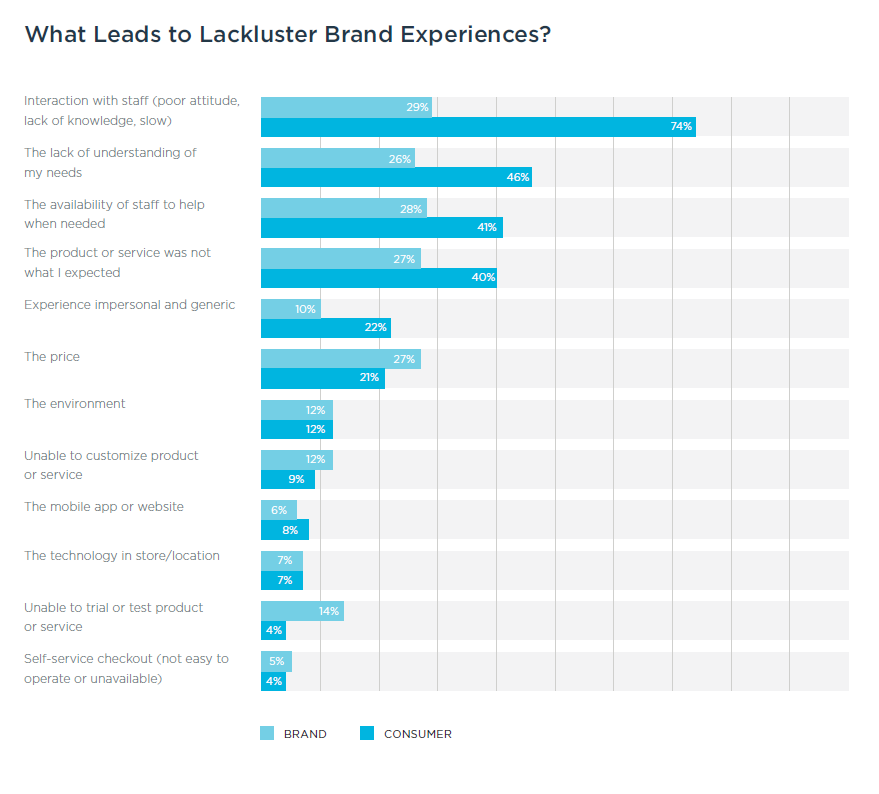Comparing Customer and Brand Perception on Key CX Elements
At one of the events I attended on behalf of CMS-Connected Media, I interviewed Chip Heath , an American bestselling author and speaker, to talk about the book called “The Power of Moments” which he co-authored with his brother, Dan Heath. One of the great points he made during our conversation was: “many of the defining moments in our lives are the result of accident or luck - but why would we leave our most meaningful, memorable moments to chance when we can create them?” This statement resonated with me so well, and I found it so applicable to Customer Experience (CX) Management, which is the focus of this article.
, an American bestselling author and speaker, to talk about the book called “The Power of Moments” which he co-authored with his brother, Dan Heath. One of the great points he made during our conversation was: “many of the defining moments in our lives are the result of accident or luck - but why would we leave our most meaningful, memorable moments to chance when we can create them?” This statement resonated with me so well, and I found it so applicable to Customer Experience (CX) Management, which is the focus of this article.
There are so many research studies out there about the state of the customer experience. However, one of them has recently captured my attention right away due to its interesting findings on many misconceptions. Without further ado, let’s delve into that research and its interesting findings.
InMoment, a cloud-based customer experience (CX) intelligence platform provider, surveyed 2,000 consumers and 1,000 brands in the U.S. to find out where both groups aligned or disconnected on various CX topics, including memorability, personalization, the use of new technologies, and other timely subjects related to the customer experience. Based on the survey results, the report covered the most important five trends.
Be Careful with What You Define as “Personalization”
Here at our website, we have previously discussed how “personalization” can veer into the “creepy” territory which serves no one other than your competitors. Apparently, that issue hasn’t been resolved yet. A whopping 75% of consumers find most forms of personalization at least somewhat creepy. Far more interestingly, 40% of brands agree with this statement. The latter data point appalled me more than the former finding as it means that almost half of the brands surveyed are creeping out customers and they know it! How lovely!
First, let’s examine what comes across as creepy for consumers:
-
Being too presumptive about consumers and their wants and likes.
-
Being emailed about a product left in a cart on a website or just recently searched feels like being stalked.
-
Being forced to share a phone number to be able to purchase a product.
-
Feeling watched and uncomfortable when a product that was previously looked at appears publicly on an unrelated page sometime later.
-
Being asked for too much information — beyond what will actually help in improving their experience.
According to the report, the biggest privacy concern related to personalization arises from the crossover between the physical and digital world. As examples, InMoment gives the cases of when Facebook is listening to what people are saying or Google knows where they’ve been.

Now that we know what consumers mean by creepy, let’s take a look at how they react to brand creepiness.
While half of the customers say they’d continue to purchase from a brand after a creepy experience, 22% report they will shift away to other brands.
If 22% didn’t sound threatening enough to you, consider this: One in five will tell friends, while one in ten will share Big Brother-type experiences on social media. So, that 22 percent may multiply in no time in today’s uber-connected world. While you are aiming your personalization marketing to translate into brand loyalty, you may end up with being creepy which may instead, translate into lost business and reputation.
Don’t Buy the Myths about Millennials
Yet another research has revealed false assumptions about Millennials (born 1981-1997) and their personal habits and preferences.
There is the tendency to assume that this generation is far less cynical about new technology than older generations, with few privacy concerns and no hesitation to give away personal information. The reality is quite the opposite, the report claims:
-
Older generations notice fewer creepy experiences from brands, while Millennials claimed the highest (at 22%, compared to 11% for the Silent Generation and 13% for Baby Boomers).
-
Millennials find online-exclusive companies (27%), apps (23%), and retailers (19%) as the biggest offenders due to their creepy marketing tactics.
The study looks into another popular misconception dictating that Millennials are exclusively digital, so much so that all of their personal and commercial interactions are done through their mobile devices. If there was an award for being the most omnichannel consumer, that would go to Millennials as it turns out, they leverage online shopping through both mobile apps and in brick-and-mortar locations.
The third myth the study revealed concerns all the generations. There is a common dichotomy saying Millennials feel that it is important or very important that brands support or invest in causes near and dear to them, however, this generation is not unique in associating brand identity to their social status as almost 55% of GenXers and 51% of Baby Boomers feel the same way when it comes to value alignment.
Besides this research study, there are many studies out there concluding Millennials are not as fickle as brands assume. In fact, they are brand loyalists demonstrating the most brand loyalty of all the generations. However, earning that position for brands is not as easy as their expectations are very specific and complex.
Cool Additions Are Not Enough to Make Your Brand Memorable
One of the areas the study shines a light on is memorability. To that point, the firm inquired if the newfangled ways have a big impact on making consumers’ experiences with brands memorable. Although the new additions such as augmented reality, pop-up stores, or facial recognition initially have a positive impact on memorability, it turns out, that impact doesn’t last so long. However, the two basics of “human interaction” and “being treated special” (exclusive offers, loyalty programs, etc.) seem to have a deeper and longer-lasting impact on the relationship between consumers and brands.
Speaking of human interactions, the report also warns brands about the human factor as it is what makes or breaks the customer experience. 65% of consumers report that “staff interaction” highly influenced their decision to buy more products from a brand, while another 65% reported that access to educators and experts is highly influential.
Another interesting point on the relationship between consumer and brand made in the report was the top elements to creating memorable experiences were asked to both consumers and brands. There is a significant difference between what each group has reported. As an example of the disconnect, 74% of consumers report that poor staff experiences (due to poor attitudes, lack of knowledge, or other reasons) contributed to a bad brand interaction. By comparison, only 29% of brands reported the same. Here is a rundown of priorities of each:

My POV
Shopping experiences go beyond a rational analysis of available alternatives, yet they are guided and emotional activities. Mobility enabled a doorway to a vast world to create a unique channel in terms of building a one-to-one relationship. However, the game of capturing attention is even tougher in this arena as people endlessly scroll through their social media newsfeed or a list of Google search results. Once a brand has managed to capture their attention, it has a pretty narrow window in which to further engage with them. Almost every brand gets a chance to either make a splash or mar their business.
In terms of B2C marketing, some tactics based on demographics may work out, however, in the B2B market, to grab full attention and convert it to action, brands should leverage intent-based marketing as opposed to crafting a message based on demographics. Given we now have, on average, four generations working side by side in an organization, making informed marketing decisions based on behavioral data is far more rewarding.

Venus Tamturk
Venus is the Media Reporter for CMS-Connected, with one of her tasks to write thorough articles by creating the most up-to-date and engaging content using B2B digital marketing. She enjoys increasing brand equity and conversion through the strategic use of social media channels and integrated media marketing plans.